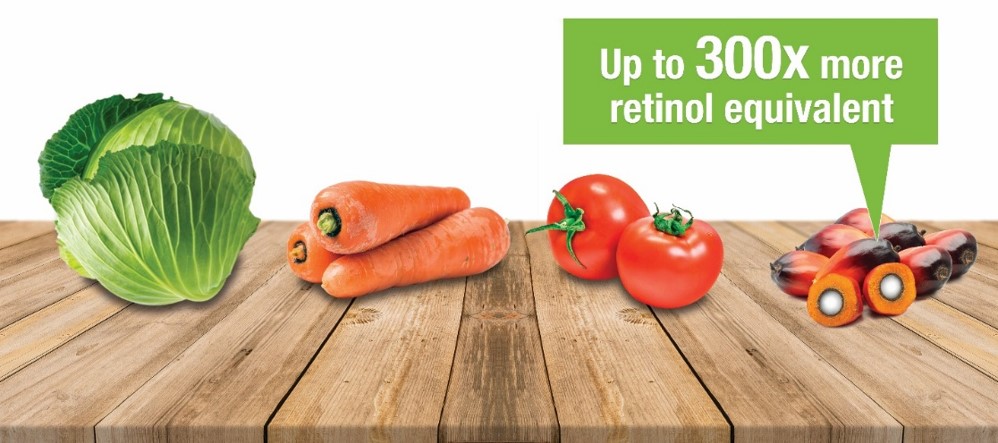PALM MIXED CAROTENES
Generally, Malaysian palm oil contains 500 to 700 ppm mixed-carotenes, of which about 35% is α-carotene while about 55% is β-carotene. It has 15-300x (as retinol equivalent) more β carotene than carrot, leafy vegetable and tomato.
High intake of α- and β-carotene (1) lowered risk of type 2 diabetes among healthy men and women, (2) slowed down age-related macular degeneration among women and (3) reduced risk of breast cancer in pre- and post-menopause women.
Carotenes are widely used in dairy, confectionery, beverage and bakery industries as natural food colourants.
DavosLife Biocarotene contains natural mixed carotenes, an ideal choice as a food colourant with rich antioxidant properties to promote general wellness.

Commercial Sources of Carotene
Generally, there are four types of carotene sources available in the market. The summary of the comparison among all the commercial sources of carotene are shown in the table below:
| Commercial Product | Algae β-Carotene | Fermentative β-Carotene | Synthetic β- Carotene | Palm Mixed Carotenes |
|---|---|---|---|---|
| Source | Algae | Fungus | Petroleum | Palm (Elaeis guineensis) |
| Composition | >96% β-carotene | >98% β-carotene | 100% β-carotene | 33% α-carotene, 65% β-carotene, 2% other carotenoids |
| α-Carotene Amount | Negligible | Negligible | None | Highest, up to 35% |
| Isomer cis-trans | Cis-trans | 100% trans | 100% trans | Cis-trans |
| Ratio and Composition Compared to Carrot | Different | Different | Different | Similar |
WHY DAVOSLIFE BIOCAROTENE?
DavosLife Biocarotene is a natural mixed carotenes extracted from non-GMO palm fruit (Elaeis guineensis). DavosLife Biocarotene contains predominantly α- and β-carotene that behave in a synergistic manner to provide health effects stronger than α-carotene and β-carotene individually. Compared to other source of market products, palm-based carotenes has the highest ratio of α-carotene to β-carotene. α- and β-carotene are scientifically proven to promote heart health, skin health, healthy ageing, glucose metabolism, bone & joint health, cognitive health and more.
α-carotene is part of the carotenoid family, and is one of the most abundant carotenoids in a healthy diet. Our body can convert α- and β-carotene into vitamin A for the maintenance of healthy skin and bones, good vision, and a robust immune system.
Because the body converts α-carotene to vitamin A, α-carotene is called a precursor to vitamin A, or a pro-vitamin A compound. As a precursor to vitamin A, α-carotene is only about half as effective as β-carotene, another well-known carotenoid. However, α-carotene may be even more effective than β-carotene in its role as an antioxidant.
Benefits of α-carotene
Mortality Risk
- Lower risk of death from any cause with higher α-carotene in blood
- Higher blood α-carotene, β-carotene and β-cryptoxanthin increase telomere length hence promote longevity
- Delay the ageing process
- Reduce risk of age-related illnesses
Eye Health
- Protect eyes against light or high-energy ultraviolet (UV) radiation
- Minimise the risks of age-related macular degeneration due to ageing
Metabolic Health
- Carotenoids-rich diet may protect against type II diabetes and diabetic retinopathy
- High intake of carotenoids attenuates the risk of type II diabetes significantly not only observed in nonsmokers and non-drinkers, but also in light drinkers
Colon Health
- Lower risk of recurrence of colon polyps, a precursor of colorectal cancer
- Higher intake of α-carotene lowers the risk of developing new polyps
Lung Health
- Lower risk of lung cancer with high intake of α-carotene
Breast Health
- Higher plasma level of α-carotene is associated with lower risk of breast cancer development and recurrence
Bladder Health
- Lower risk of invasive bladder cancer in men and women with higher intake of α-carotene
Heart Health
- Plasma α-carotene level is significantly lower in the heart disease patients
Bone & Joint Health
- Promote bone health by increasing bone mineral density
- High levels of α-carotene is associated with increased bone mineral density at most skeletal sites in women and men
PRODUCT RANGE
Palm-Mixed Carotenes, Liquid
A reddish orange oil concentrate containing the natural form of α- and β-carotene mixture. It is miscible with a variety of oils, contains approximately 30% mixed carotenes, the highest in the market. The product range includes:-
- DavosLife Biocarotene PMC30 MCT
- DavosLife Biocarotene PMC30 SFO
APPLICATIONS
Palm mixed carotenes contains the highest ratio of α- to β-carotene that function synergistically to confer unique health beneficial properties. It is a true natural food colourant with a valuable nutritional profile.
| Applications | Colour Shades | Examples |
|---|---|---|
| Bakery | Yellow to Orange | Bread, cookies, cream, cereals |
| Beverages | Fruit juices, soft drinks | |
| Condiments | Salad dressings, sauces, mayonnaise | |
| Confectionary | Candies, snacks, chocolates | |
| Dairy | Cheese, ice cream, milk, yogurt | |
| Edible fats & oils | Cooking oil, butter, margarine |
Food Safety Landscape
Generally Recognised As Safe (GRAS)
Palm Carotenoids are GRAS affirmed by the U.S. Food and Drug Administration (FDA) as a permitted ingredient to be formulated in dietary supplements, functional food and beverage products, animal feed additives and even cosmetics.
Food Additive As Natural Colourant
Carotenes are used as natural ingredient to give colour from yellow to orange in the food and beverage products such as juices, cakes, desserts, butter and margarine. It is approved for use as a food additive in the EU (listed as colour additive E160a) Australia and New Zealand (listed as 160a).
Recommended Daily Intake
European Food Safety Authority (EFSA) set Population Reference Intakes (PRIs)
- 750 μg Retinol Equivalent (RE)/day for men
- 650 μg RE/day for women
- 250 to 750 μg RE/day for infants and children
- 700 and 1,300 μg RE/day, respectively for pregnancy and lactation. Additional vitamin A requirements related to the accumulation of retinol in fetal and maternal tissues and transfer of retinol into breast milk.
Note: 1 µg RE = 1 µg retinol = 6 µg β-carotene = 12 µg of other pro-vitamin A carotenes (e.g. α-carotene)
